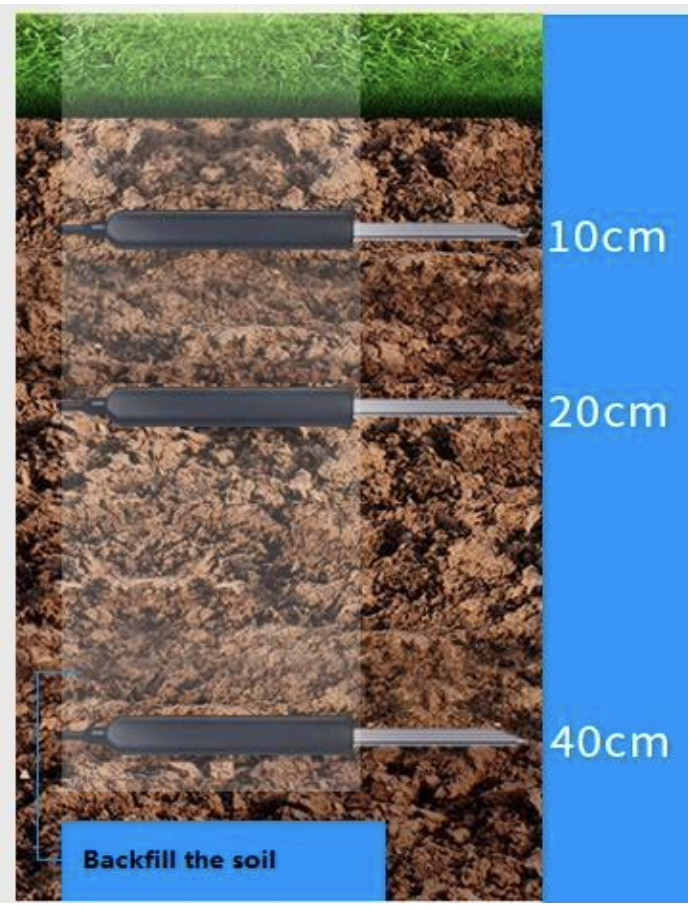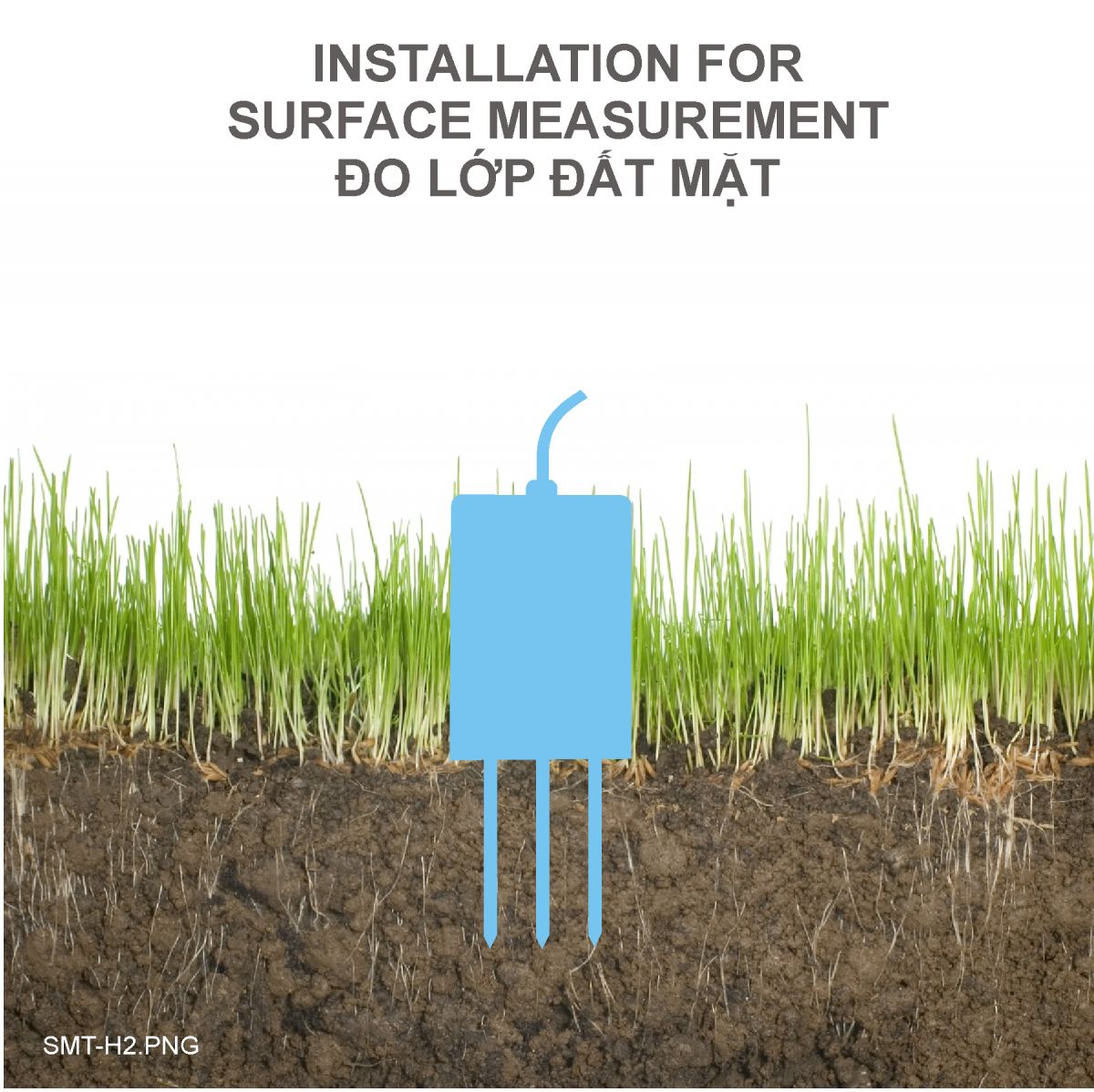Daviteq SMT Soil Moisture and NPK Sensor - Measurement Principle
1. Introduction
1.1 Overview
Daviteq SMT is a Soil Moisture and NPK sensor that can simultaneously monitor soil temperature, humidity, conductivity, salinity, nitrogen, phosphorus, and potassium values in soil. By measuring the dielectric constant of the soil, it can directly and stably reflect the true moisture content of various soils. It can measure the volume percentage of soil moisture, which is a soil moisture measurement method that meets the current international standards. By measuring the electrical conductivity of the soil, the salinity reflects the salinity of the soil in time, and by measuring the nitrogen, phosphorus, and potassium content of the soil, it reflects the nutrient status of the soil in time, providing data basis for scientific planting.
It has ultra-low power consumption to allow it to be integrated with Wireless Devices such as Sub-GHz transmitter, Sigfox transmitter, LoRaWAN transmitter, RS485 output transmitters, etc.
1.2 Highlight Features
-
- The seven parameters of soil water content, electrical conductivity, salinity, temperature and nitrogen, phosphorus, and potassium are combined into one;
- Low threshold, few steps, fast measurement, no reagents, unlimited detection times;
- It can also be used for the conductivity of water and fertilizer-integrated solutions, and other nutrient solutions and substrates;
- The electrode is made of specially processed alloy material, which can withstand strong external impact and is not easy to damage;
- Completely sealed, and resistant to acid and alkali corrosion can be buried in soil or directly into the water for long-term measuring;
- High precision, fast response, good interchangeability, probe plug-in design to ensure accurate measurement and reliable performance;
- Typical Applications of Daviteq SMT Soil sensor.
1.3 Typical Applications of Daviteq SMT Soil Sensor
The SMT sensor is suitable for soil moisture monitoring, scientific experiments, water-saving irrigation, greenhouses, flowers and vegetables, grassland pastures, soil rapid testing, plant cultivation, sewage treatment, and precision agriculture...
1.4 Specification
| Sensor Types | SMT-07 | SMT-01 |
| Sensor technology | FDR Capacitance | FDR Capacitance |
| Measurement Parameters |
Soil moisture, Temperature, EC, Salinity, and NPK |
Soil moisture, and Temperature |
| Temperature measuring range / Resolution / Accuracy |
-40° C~80° C / 0.1 / +/- 0.5 |
-40° C~80° C / 0.1 / +/- 0.5 |
| Soil Moisture range / Resolution / Accuracy |
0 - 100% vol. / 0.1 / 0-50%: ±2%; 53%-100%: ±3% |
0 - 100% vol. / 0.1 / 0-50%: ±2%; 53%-100%: ±3% |
| Electrical Conductivity range / Resolution / Accuracy | 0 - 20.000 us/cm / 1 / +/- 3% of reading | N/A |
| Salinity range / Resolution / Accuracy | 0 - 10.000 ppm / 1 / +/- 3% of reading | N/A |
| N,P,K range / Resolution / Accuracy | 1 - 1999 mg/kg / 1 / +/- 2% of Full scale | N/A |
| Response Time | < 15s | < 15s |
|
Conductivity temperature compensation |
Built-in compensation in range 0 - 50 oC | N/A |
| Working temperature | -40 .. + 80 oC | -40 .. + 80 oC |
| Working humidity | 0 - 100 %RH | 0 - 100 %RH |
| Ingress Protection | IP68 | IP68 |
| Housing materials | ABS plastic with potting | ABS plastic with potting |
| Electrode material | 316SS | 316SS |
2. Principle of operation
FDR (Frequency Domain Reflectometry) type sensor is mainly composed of a parallel arrangement of the metal bar as a capacitor. In which the soil acts as a dielectric, the capacitor and oscillator are composed of a high-frequency tuning circuit. The electromagnetic wave through the coaxial cable arrives at the probe, and the resonance frequency is detected by the frequency sweep circuit. The dielectric constant of the soil can be measured so that the soil water content is obtained. The dielectric constant of water is 80 F m-1 and the soil solid dielectric constant is 2~5 F m-1; the dielectric constant of water is much bigger than soil. Therefore, the dielectric constant of soil is mainly affected by soil moisture content. Moisture content increases, the soil dielectric constant will increase accordingly, and the frequency of the electromagnetic wave propagation will change.
Besides the moisture content, the sensor also can measure the electrical conductivity of the soil and calculate the other parameters like Salinity, N, P, and K.
Operating principle for soil water content measurements.
Sensor and soil act as oscillating circuits with an inductor and capacitor.
3. Calibration of the Daviteq SMT Soil Sensor
The Daviteq SMT Soil Sensor is pre-calibrated with standard soil before shipping. Users can make further adjustments/calibrations in their software or reading device to meet higher accuracy for their specific soil.
4. Application notes for the Daviteq SMT Soil Sensor
- FDR sensors need to have good contact with the medium they measure with no air gaps;
- Since the electrode directly measures the conductivity of the soluble salt ions in the soil, the soil volumetric water content must be higher than about 20% when the soluble ions in the soil can accurately reflect the conductivity of the soil. In the long-term observation, the measured value after irrigation or rainfall is closer to the true level. If you are performing a quick test, you can water the soil to be tested first, and perform the measurement after the water is fully penetrated;
- The sensor should be protected from severe vibration and impact, let alone knocked with hard objects;
- Because the sensor has a black housing, the sensor will heat up sharply (up to 50°C) under strong sunlight. In order to prevent excessive temperature from affecting the temperature measurement of the sensor, please pay attention to shading and protection when using it in the field.
5. Installation notes
General Notes:
* All the metal electrodes must be inserted into the soil during measurement;
* Avoid direct sunlight on the sensor, which will cause excessive temperature;
* Do not bend the metal electrodes violently, do not pull the sensor lead wire with force, and do not beat or violently impact the sensor;
* The protection grade of the sensor is IP68, which can soak the sensor in water;
5.1 Soil Surface Measurement:
- Clean the soil surface by removing the debris, and vegetation...
- Insert the electrodes completely in the soil, as in the below picture;
- If you measure on a hard surface, you should drill a hole first (the hole diameter should be smaller than the probe diameter), then insert it into the soil and compact the soil before measuring;
5.2 Multi-layer Measurement
- Make a soil profile in the vertical direction, slightly deeper than the installation depth of the bottommost sensor, between 20cm and 50cm in diameter;
- Insert the probes horizontally at different layers of soil;
- After the installation is completed, the excavated soil is backfilled in order, layered, and compacted, and horizontal installation is guaranteed.
| 3-layer measurement | 6-layer measurement |
 |
 |
6. Troubleshooting for the Daviteq SMT Soil Sensor
| No. | Phenomena | Reason | Solutions | |
| 1 | The measured value is not within the expected value. | 1.1 | The soil is not compact. | Make sure the soil is compact and there are no air gaps between the soil and electrodes |
| 1.2 | The soil is special | Calibrate or adjust the reading values on software or reading device based on the actual values of that soil. | ||
| 1.3 | The sensor was spoiled. | Please consult the manufacturer for a warranty or replacement. | ||
| 2 | The measured values of EC, Salinity, and NPK are always zero or near zero. | 2.1 | The soil moisture is too low, less than 20%. Therefore the circuit cannot measure the electrical conductivity of the soil | Watering the soil and/or keep holding the last values of EC, Salinity, and NPK in the Software system or reading device. |
| 2.2 | The sensor was spoiled. | Please consult the manufacturer for a warranty or replacement. | ||
| 3 | HW_Error = 1 | 3.1 | Loosed connection of sensor probe and wireless transmitter. | Check the sensor cable and connector. |
| 3.2 | The sensor probe got a problem. | Please consult the manufacturer for a warranty or replacement. |
7. Maintenance of the Daviteq SMT Soil Sensor
The SMT soil sensor is a maintenance-free sensor.
8. Default configuration
This SMT soil sensor has the default configuration, however, those parameters can be changed. The user can change the configuration on the wireless transmitter so that the complete sensor (transducer + wireless) delivers the proper output value. Below are some configuration parameters that store in the flash memory of the wireless transmitter.
8.1 For SMT-07
| Description | Unit | Default | Format | Property | Comment |
8.2 For SMT-01
| Description | Unit | Default | Format | Property | Comment |
END.



No Comments